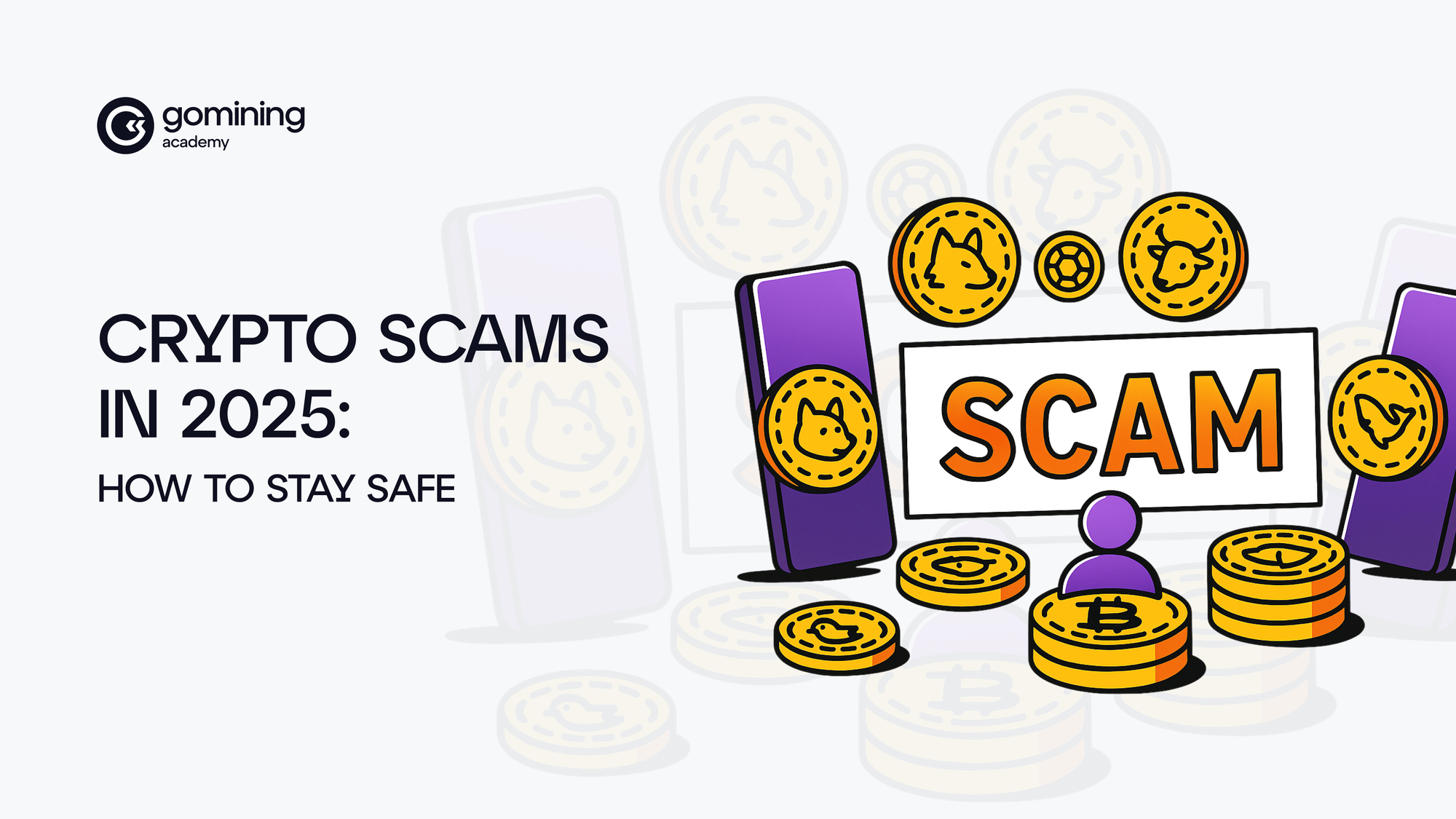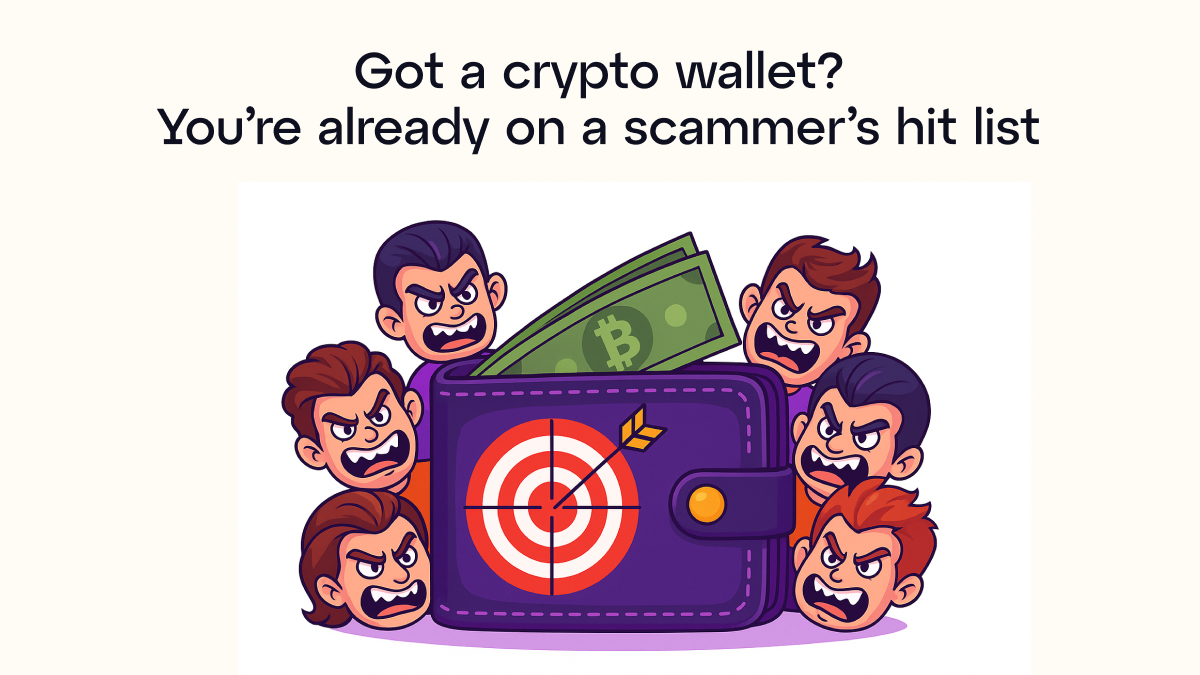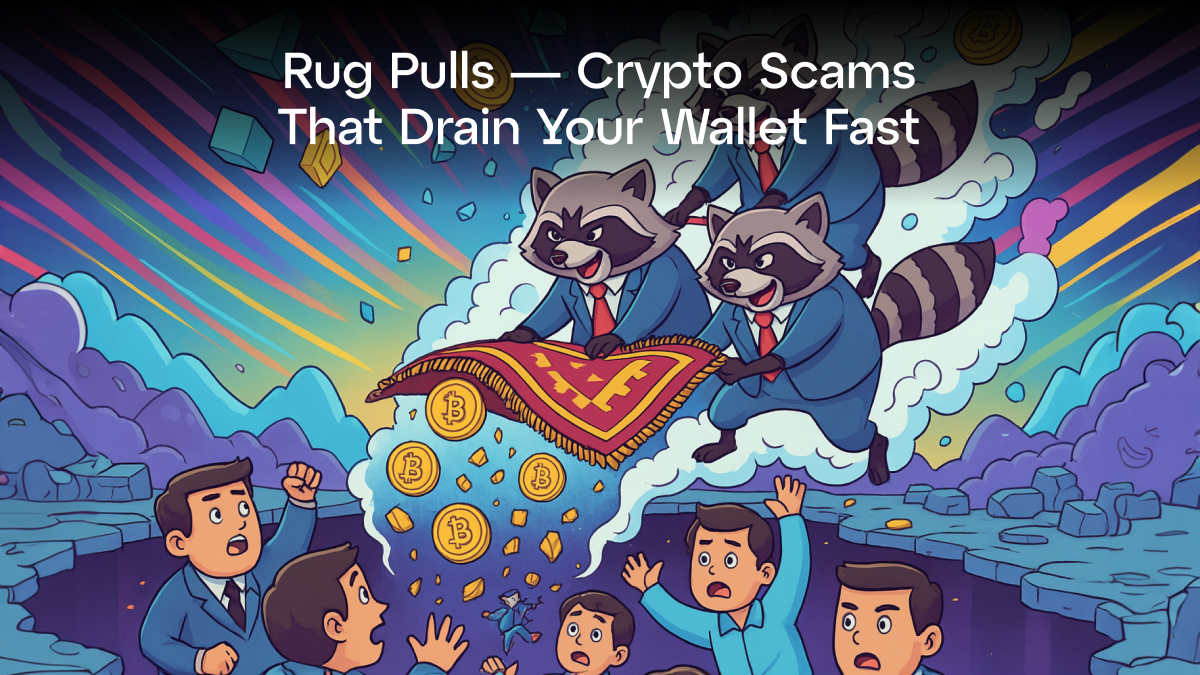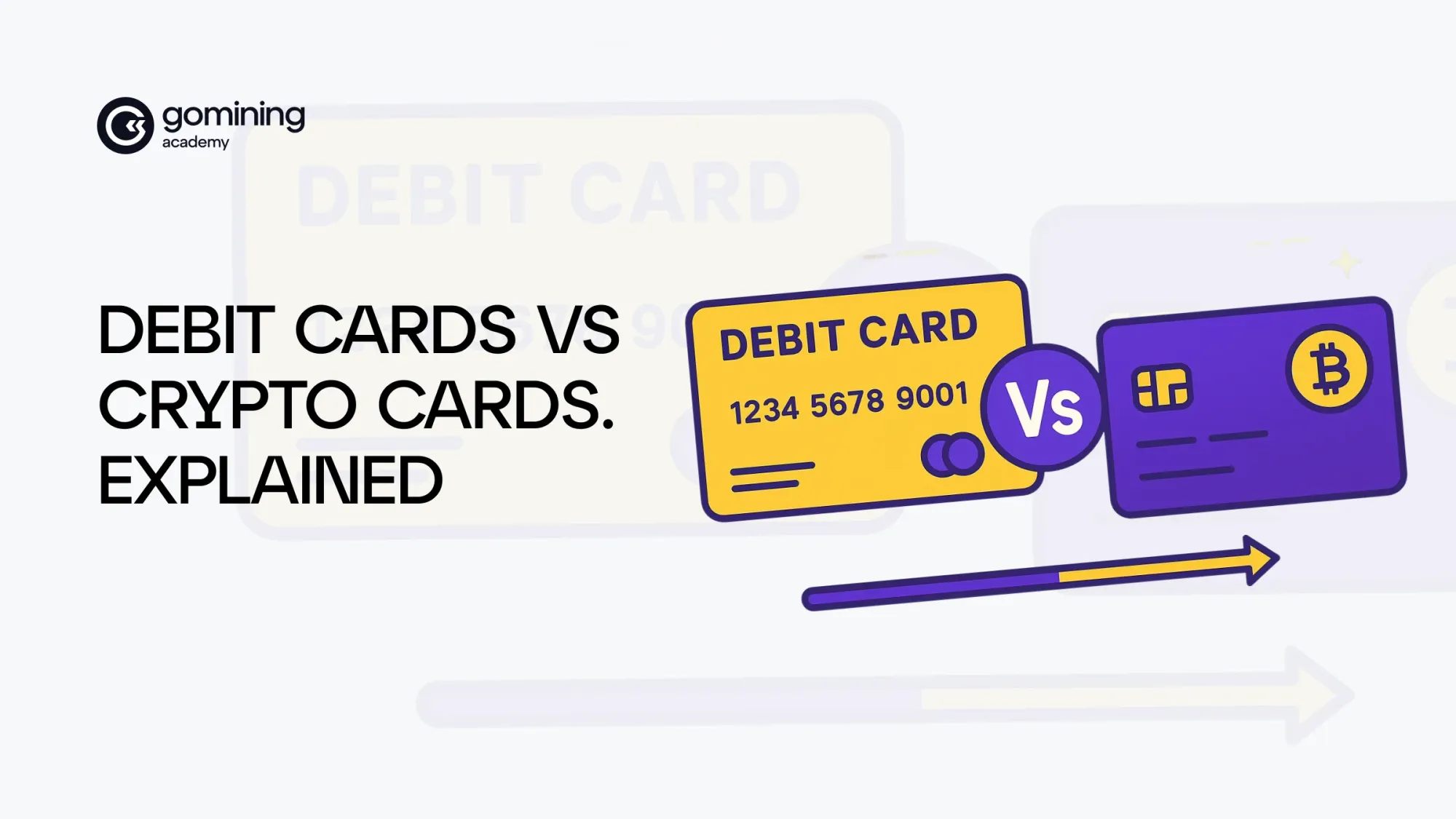Crypto Scams in 2025: How to Stay Safe

Have you ever wandered into your spam folder, just for kicks? Who knows, maybe a long-lost foreign prince is finally ready to split his billion dollar fortune? Instead, you find:
“Join our VIP crypto group—our AI trading bot delivers 40 % weekly profits. Only 10 spots left!” – Classic!
In the Wild West of the internet, your inbox is a digital bazaar—overflowing with neon promises, 🚀 emojis, and a sales pitch juicier than Satoshi’s secret diary. But behind the dazzle lurk the same old scams, dressed up in AI and FOMO.
Googling a “Bitcoin scammer list” won’t save you—the fraudsters are always one step ahead. Whether you’re fresh to crypto or have scars from the last cycle, the traps are everywhere. The closest thing to a scams watch is the Department of Financial Protection and Innovation DFPI that has its scams tracker.
This article shines a light on 2025’s slipperiest scams—and how to dodge them like a pro.
Table of Contents
- Crypto Scams: No Chargebacks, No Mercy, No Way Back
- Deepfake-Driven Crypto Scams
- High-yield Investment Crypto Scams and Ponzi Schemes
- Cloud Mining Bitcoin Scams
- How to Spot a Bitcoin Scammer
- Rug Pulls—Crypto Scams That Drain Your Wallet Fast
- How to Identify Fake Cryptocurrency
- Bitcoin Atm Scams
- Curtain Call: Don’t Let the Crypto Scammers Steal the Show
🕵️♂️ Crypto Scams: No Chargebacks, No Mercy, No Way Back
What is one of the biggest red flags in the crypto scammer playbook?
They only accept payments in crypto. Because they know there’s no way for you to get that money back.
In the world of crypto, there are no takebacks. No bank to call. No manager to beg. No “Oops, wrong address” button. Send crypto to the wrong wallet, and it’s like dropping it into a black hole. No one’s coming to rescue it. No refunds. No reversals. The blockchain just executes—blind, brutal, and final.
Unlike most other scams, crypto scams offer no lifeline once your coins are sent. For example, when you get scammed using a credit card, you’ve got a lifeline. You can dispute charges. Banks can reverse payments. You might get reimbursed. But not in crypto. Crypto scams thrive on finality. Once you send the funds, it’s over. No chargebacks. No freezing their wallet. No one to sue. No paper trail. No middlemen.

In the crypto world, your wallet is your bank. It holds your digital money—but without the usual safety nets. There’s no fraud hotline. No account recovery. No “reset my password” button. If someone tricks you into sending funds or gaining access to your wallet, your money is gone forever.
That’s why so many crypto scams focus on tricking you out of your wallet credentials. Because once you make a mistake, there’s no undo button. And no one—not the blockchain, not the cops, not the universe—can reverse it.
💡So, how do you keep your coins safer than Satoshi’s secret stash?
- 🧊 Use a hardware (cold) wallet. Devices like Ledger or Trezor store your private keys offline, away from internet threats. Even if your computer gets hacked, your coins are safe as long as the attacker doesn’t have the physical device.
- 🔐 Enable multi-factor authentication (MFA). Set up 2FA or SMS verification on every exchange, wallet, and email tied to your crypto life. This alone blocks nearly all attackers, even if they somehow steal your password.
With these basics, you can make your wallet a whole lot less tempting to the scammer crowd.
⚠️ Scammer’s Delight: Your Sweet, Sweet Seed Phrase
Unlike your bank app, crypto wallets don’t use a username and password. Instead, they’re guarded by a seed phrase—a secret list of 12 or 24 random words.Think of it like a master key to your vault. Anyone who gets it can take everything. No PIN. No alerts. No second chances.

That’s why your seed phrase is a scammer’s favorite snack. They’ll pretend to be tech support, run fake giveaways, or create phishing sites that look nearly identical to real ones—all to get you to hand it over.
And if you do? Your funds are as good as gone.
💡If somebody asks for your seed phrase, run to the hills!
Crypto Phishing Scams
Among the most sophisticated cryptocurrency scams of 2025 are crypto phishing schemes. Victims click a convincing link—often shared in a hacked Discord or Telegram channel—and land on a perfect replica of their favorite exchange, where they’re coaxed into revealing their seed phrase.
The attackers then drain the victim’s accounts using the seed phrase that they had just harvested. To stay safe:
- Keep a personal list of fake crypto apps and URLs you’ve encountered.
- Enable hardware-wallet confirmation for every transfer.
- Finally type exchange addresses manually rather than trusting links dropped in chat rooms or emails.
Deepfake-Driven Crypto Scams
This one is straight out of sci-fi. Picture getting a frantic video call from your boss’s face, “urgent invoice” on screen – but it’s actually a voice clone asking for a wire transfer. In 2024, an engineer at UK firm Arup got tricked into sending $25 million this way.
Fraudsters can clone anyone’s voice or even fake livestreams of celebs to lure victims. (We’re talking AI Musk endorsing a “giveaway” or “your CEO needs help with crypto” scams.) The tech is uncanny: AI-powered crypto scams now include deepfakes, voice cloning, and chat bots that impersonate real people.
How do you dodge an AI con artist? First, slow down. If you really got a call from the boss – call them back on a known number. A quick “Hey wait, I’m not trading crypto from Paris” can save millions. Remember, deepfake tech can generate convincing video and audio, so never trust an urgent money request just because someone on Zoom looks or sounds official.
High-Нield Crypto Investment Scams and Ponzi Schemes
Among the riskiest crypto scams in 2025 are high-yield investment schemes and Ponzi setups promising guaranteed returns. These crypto scams promise you guaranteed crazy returns – “13.5% per month” or “double your crypto in a week!” – and pressure you to put money in quickly.
In reality, it’s usually just a Ponzi scheme in a shiny crypto wrapper. The “returns” you see? They're not profits—they’re recycled money from the poor souls who joined after you.
Think of it like a financial game of hot potato. Everyone’s passing the money around, hoping they’re not the last one holding nothing when the music stops. No real investing, no magic trading bots—just a digital shell game where early birds get paid with the next pigeons’ coins. And when the hype runs out? Boom. Vanishes faster than a meme coin on Monday.
For example, in 2024 regulators shut down two brothers who ran a crypto Ponzi promising 13.5% monthly returns with a “magic trading bot.” They raised $60 million and splurged it all on yachts (spoiler: their “bot” was fake). Remember, if someone offers sky-high returns with no risk, it’s a classic con.
🎯 Spotting the Red Flags (Without Needing a PhD in Crypto)
Think of them like sketchy strangers whispering "get rich quick" in a dark alley. Don’t walk—run. Here’s your survival kit:
- Trust your gut. If the returns sound too good to be true (“double your crypto overnight!”), they are. Real investments take time—and come with risk.
- No DMs, no deals. Legit platforms won’t slide into your inbox offering secret riches. If someone’s pitching magic profits in your Telegram or Instagram DMs, hit block and move on.
- Google before you give. Look up the company, the people behind it, and see if regulators (like the SEC or FCA) have issued warnings. If your search pulls up lawsuits instead of LinkedIn profiles, that's your cue.
Bottom line? If it smells fishy and promises gold—it’s probably a glittery trap.
Cloud Mining Bitcoin Scams
Just when you thought you’d escaped the fake giveaways and deep-fake CEOs—enter: Cloud Mining Scams, one of the slickest Bitcoin scams now sweeping the scene. On the surface, cloud mining sounds like the dream, right? No noisy rigs, no overheating GPUs—just sweet, passive crypto income while you sip coffee. But in 2025 this dream became perfect camouflage for every flavor of Bitcoin scam artist.
Crypto scammers now mimic legit mining platforms with flashy dashboards, live “hash-rate” stats, and even fake Bitcoin transaction screenshots. HashFlare, the Estonian “cloud mining” operation, promised passive crypto riches—but was mostly selling hot air.
Despite raking in over $577 million, prosecutors later revealed the operation had almost no actual mining hardware. Victims were shown slick dashboards with fake stats and “daily earnings,” but it was all smoke and mirrors. Behind the scenes? No mining, no profits—just a sneaky shuffle where older investors were paid with money from new ones. Classic Ponzi in a crypto costume.
It was like a digital pyramid scheme where the only thing being mined was people’s trust. Meanwhile, the founders laundered the funds into luxury real estate and fancy cars, all while preaching “financial freedom” like it was gospel. Turns out, the only thing they were freeing was your wallet—from your money.
A more recent example is BTCMining Ltd., a UK-registered crypto business that was shut down by the High Court in Manchester after complaints rolled in from as far as Romania, Estonia, and New Zealand. Investors had lost thousands of pounds, but the real kicker? The registered office was just someone’s house—and the resident had no idea they were hosting a crypto “company.” Classic.
These cases show how even official-looking platforms with shiny websites and UK business numbers can be absolute smoke and mirrors. Whether it’s Tallinn or London, the rules stay the same: if you can’t verify the mining, track the payouts, or even confirm the business exists beyond a PO box and a Wix page—run. Cloud mining remains one of the most persistent types of crypto scams—especially for those chasing passive income.
How to Spot a Bitcoin Scammer
A genuine Bitcoin deal never needs you to rush, hush-hush, or hand over your private keys—so treat any pitch that mixes those three as a screaming red flag. Start by asking, “Can I independently verify this?” Check the domain (is it an obvious misspelling or a fresh registration?), the social pages (do the followers look real, not bots with anime avatars?), and the blockchain itself (trace a sample TxID on a public explorer—if you can’t find it, run).
Beware “guaranteed” daily returns, celebrity endorsements that only exist in Photoshopped tweets, and slick dashboards that show profits you can’t actually withdraw. If the rep dodges video calls, insists on Telegram-only support, or pushes you toward an “exclusive” wallet download, you’ve likely met a Bitcoin scammer—back away before your coins do.
Rug Pulls—Crypto Scams That Drain Your Wallet Fast
Beyond the false promises of easy Bitcoin mining, another common trap lies in the form of crypto tokens. In the world of Web3, a token is like a digital coin—but it can do more than just sit in your wallet. Some tokens act like currency (stablecoins), others give you voting power in a crypto scamproject (governance tokens), and some unlock features in games or apps.
Think of them as tiny keys that open different digital doors depending on where you’re using them.

Here’s where the craze comes in: anyone can create a token on blockchains like Ethereum or Solana—and many do. Some projects launch with solid ideas and real communities. Others just slap together a meme, a website, and a flashy promise. It’s easy to get swept up in the hype, but it’s just as easy to fall for a trap.
Rug pulls have become infamous among the many crypto scams in the DeFi world. In crypto, a rug pull is when shady developers create a flashy new token, hype it up like it’s the next Bitcoin, get people to invest—and then pull the rug. They drain the project’s liquidity (the actual value backing the token) and disappear, leaving everyone holding worthless coins.
It’s one of the most common crypto scams in DeFi, especially with brand-new tokens or memecoins that blow up overnight on social media. These are tokens based on internet jokes, pop culture, or pure chaos. Think DOGE, PEPE, or WIF. They often start as fun experiments with no serious purpose, but sometimes they explode in popularity thanks to hype, humor, and a dash of FOMO.
While some folks have made big gains, many others got left holding the bag when the buzz faded and the value vanished. Memecoins are like digital lottery tickets: thrilling, but risky.
Remember the 2021 “Squid Game”crypto? That was a classic honeypot – folks could only buy the token, never sell.
🎯How to Identify Fake Cryptocurrency
New coin or DeFi project caught your eye? Cool—but don’t get swept up by the hype. Here’s how to do a basic vibe check:
- Google the team – If no one’s willing to show their face or name, that’s a red flag bigger than a circus tent.
- Try a small “test” buy – See if you can sell a little right after. If you can’t get your money out… that’s your cue to exit stage left.
- Avoid the magic words – “Free airdrop,” “guaranteed returns,” “locked tokens” = classic bait. Real projects don’t need to shout.
And most importantly: don’t throw all your eggs (or crypto) into one sketchy basket. A little caution goes a long way. 🎪💸
Bitcoin ATM Scams
And now for a real-world scam that literally sends people running to the nearest corner store: Bitcoin ATM scams. Bitcoin ATM fraud is one of the fastest-growing crypto scams targeting vulnerable users. According to new data from the FTC, Americans lost a jaw-dropping $65 million to these crypto scams in just the first half of 2024. That’s a 10× spike since 2020—and older adults are especially vulnerable, losing more often and more per incident.
Here’s the setup: you get a panicked call from “Apple Support,” your “bank,” or even someone claiming to be from the IRS. They spin a crisis—“your account’s compromised,” “you owe taxes,” “your grandson’s in jail”—and tell you the only way to fix it is to withdraw cash and deposit it into a Bitcoin ATM they direct you to. Sounds sketchy? That’s because it is. Once you scan their QR code and hit send, the money is gone forever.
The median loss in these crypto scams? $10,000. Each. That’s not a typo. And the crooks often target people over 60, relying on urgency, fear, and a general unfamiliarity with crypto. So if anyone tells you to solve a crisis with a QR code and a pile of cash—walk the other way and call someone you trust. No legit company or government agency asks for Bitcoin at a gas station kiosk.
🎬 Curtain Call: How to Avoid Crypto Scams
Crypto may be the future of finance, but let’s be real—2025 fintech is still a little rough around the edges. Between deepfakes, fake trading bots, and honeytrap tokens, crypto scams are getting more creative.
But here’s the thing: you don’t have to be a blockchain engineer or DeFi wizard to stay safe and protect your assets. Just stay curious, stay skeptical, and watch for those tell tell signs such as sending Bitcoin to anyone who’s more emoji than substance.
If a deal sounds like magic, ask yourself: “Would I trust this with my grandma’s savings?” If the answer is no—back away, delete, block, and pour yourself a coffee instead.
Crypto is about financial freedom, not financial fragility. So suit up with knowledge, lock down your wallets, and remember: 🚫 No seed phrase sharing. 🚫 No urgent QR code deposits. 🚫 No such thing as guaranteed riches. ✅ Just you, your keys, and a healthy dose of digital street smarts.
Now go out there and be the kind of crypto user a scammer has nightmares about. 🧠🔐💪
Legit Earning Paths—Filtering the Real From the Fake
There are many crypto investments that are transparent, and use blockchain technology to show how they work. GoMining is one such app that offers digital mining as a service.. Not sure really what digital mining is or cloud mining, then read the neutral comparison Digital Mining vs Cloud mining to understand the better choice for your crypto journey,
GoMining’s NFT Bitcoin miners are blockchain-based proof that a real Bitcoin-mining machine is working on your behalf in a real facility, around the clock. Reputable platforms like GoMining back up their claims with hard evidence. The platform has a list of GoMining hashpower providers that displays live data-centre stats—location, power capacity, uptime—so you know real machines exist.
Running real machines is only half the picture; fee efficiency matters too. Paying costs with the native GoMining token—whose mechanics are detailed under crypto tokenomics—unlocks discounts that stack with the tieredGoMining VIP rewards program
Want to check potential earnings? Plug your numbers into the crypto profit calculator; it shows realistic profits after fees, making it easy to spot any service that’s inflating its returns.
Prefer your passive income with a dash of collectibles? Grab GoMining digital avatars from the wider GoMining avatar collections, then level them up inside the on-chain Bitcoin mining game known to many players as Miner Wars. Each avatar channels hash-power to your balance while turning security tips into in-game quests—a far cry from the empty “stake-and-fake” NFT drops scammers tout.
Add the evergreen GoMining referral program and small, steady kickbacks roll in without shady “invite-10-friends” pressure. Whether you’re collecting avatars or optimising yields with GoMining’s digital token, these vetted resources keep you on the right side of the scam line.
If you are aware of how to mine Bitcoin then you’ll know that mining Bitcoin can be costly and require a lot of effort. Is GoMining worth it? GoMining is a new innovative way of doing Bitcoin mining. It offers you the opportunity to mine Bitcoin but without the huge commitment of investing millions and spending long hours working out what went wrong in the software running your rigs.
Choosing a Bitcoin mining app like GoMining is an easy way to mine Bitcoin through the convenience of your own mobile phone. GoMining is the best Bitcoin miner app to do this, because it is based on digital mining.


